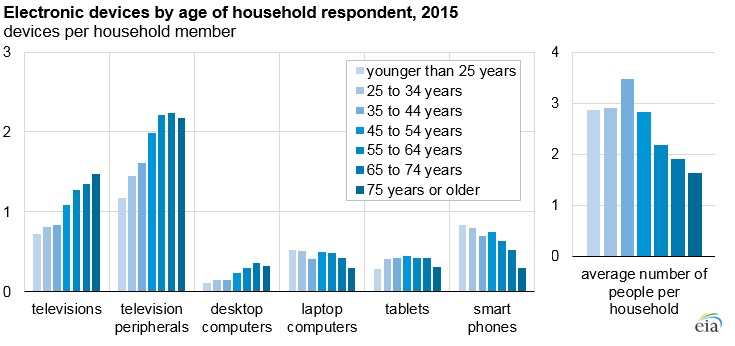WASHINGTON – (RealEstateRama) — An average of 2.3 televisions were used in American homes in 2015, down from an average of 2.6 televisions per household in 2009, according to the Residential Energy Consumption Survey (RECS), released today by the U.S Energy Information Administration (EIA). The number of homes with three or more televisions declined from the previous survey conducted in 2009, and a larger share of households reported not using a television at all.

Data from the 2015 RECS highlight the variability and trends in energy use across the nation’s more than 118 million single-family homes, apartments, and mobile homes. Entertainment and information devices in particular vary by age: younger households tend to have a lower concentration of televisions per person and a higher concentration of portable devices like laptops and smart phones. Older households are more likely to have higher concentrations of desktop computers.
In addition to electronics, new household characteristics tables contain information about heating, air conditioning, appliances, water heating, structural features, and lighting.
Other findings of the 2015 RECS include:
- 70 million homes (59%) have double or triple-pane windows
- Homeowners are more likely than renters to have energy-efficient LED lightbulbs; only 11% of households report having all incandescent bulbs
- The number of homes heating with fuel oil continues to decline, down 23% from 2005
- 77 million households use central air-conditioning, up 17% in the last 10 years
- Although more than half of all households have a programmable thermostat, only one-third of those households use the programming feature to automatically set the heating temperature
EIA’s 2015 RECS Household Survey captured more than 200 energy-related items from more than 5,600 households. Several questions remain similar to those in previous surveys, allowing time-series analysis using RECS data back to the late 1970s. However, as energy use in households changes, new questions are added or old ones are revised. The 2015 survey was the first to include questions about tablets, smart thermostats, and light-emitting diode (LED) lighting.
Prior to the 2015 survey, RECS household characteristics data were collected solely by in-person interviews conducted by field staff. The 2015 RECS is the first time online questionnaire and mail-in paper survey modes were offered as response options. Of the 5,600 respondents, about 43% were conducted through in-person interviews, 37% through online questionnaires, and 20% through mail-in paper surveys.
Household characteristics summary tables, including data about the types of fuels used and equipment installed in households, are the first in a series of data releases from the 2015 RECS. A microdata file with household-level data, which allows more detailed analysis than the summary tables provide, is scheduled for release in April 2017.
As part of the RECS, EIA also collects energy billing data from utilities and other household energy suppliers. These data are used to estimate aggregate household energy consumption and expenditures, as well as to disaggregate household energy use into specific end-uses such as heating, cooling, water heating, and refrigeration. EIA plans to release these RECS Consumption and Expenditures estimates beginning early 2018.
RECS 2015 household characteristics data can be found at: http://www.eia.gov/consumption/residential/data/2015.












